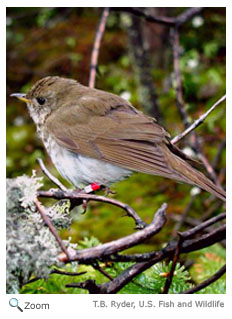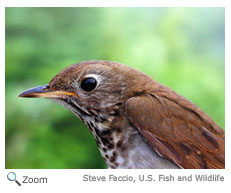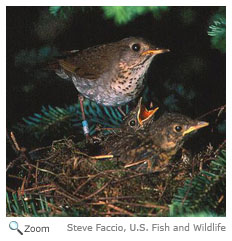Description
 The Bicknell's thrush is difficult to see, but easy to hear. It likes to sing from the tops of dead trees that stand high above other trees and shrubs. It is a small bird at only 6-7.5 inches. The Bicknell's Thrush has an olive brown head, back and wings, whitish-gray belly with brown spots. The Bicknell's thrush is difficult to see, but easy to hear. It likes to sing from the tops of dead trees that stand high above other trees and shrubs. It is a small bird at only 6-7.5 inches. The Bicknell's Thrush has an olive brown head, back and wings, whitish-gray belly with brown spots.
Range
The Bicknell's Thrush has a very small, fragmented range and lives in a specific habitat. In the summer, it lives in southeastern Canada and distinct mountain spots in New England and northern New York. In the winter, the Bicknell's Thrush lives on the Caribbean islands of Cuba, Haiti, the Dominican Republic and Puerto Rico.
Habitat
 The Bicknell's Thrush breeds in specific fir and spruce forests in the mountains and along the coast. It seems to prefer recently disturbed areas, such as places that have just been logged. In the winter, the thrush lives in broadleaf forests in the Caribbean. The Bicknell's Thrush breeds in specific fir and spruce forests in the mountains and along the coast. It seems to prefer recently disturbed areas, such as places that have just been logged. In the winter, the thrush lives in broadleaf forests in the Caribbean. |
|
Diet
 The Bicknell's Thrush hops along the ground making short flights between trees looking for food. It eats insects and other invertebrates found on the forest floor. The thrush also eats fruit. The Bicknell's Thrush hops along the ground making short flights between trees looking for food. It eats insects and other invertebrates found on the forest floor. The thrush also eats fruit.
Life Cycle
 With twigs and moss, the Bicknell's Thrush builds a nest in the shape of an open cup. In the nest, the female lays 3-4 bluish green eggs with light brown spots. Upon hatching, the young chicks don't have any feathers and are helpless. They rely on their parents for food until they first leave the nest after 9-13 days. With twigs and moss, the Bicknell's Thrush builds a nest in the shape of an open cup. In the nest, the female lays 3-4 bluish green eggs with light brown spots. Upon hatching, the young chicks don't have any feathers and are helpless. They rely on their parents for food until they first leave the nest after 9-13 days.
Behavior
 Due to its small range and specific habitat, scientists believe that there are only 50,000 Bicknell's Thrushes today. Habitat loss in both its summer and winter range are contributing to its vulnerability. Due to its small range and specific habitat, scientists believe that there are only 50,000 Bicknell's Thrushes today. Habitat loss in both its summer and winter range are contributing to its vulnerability. |





